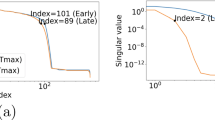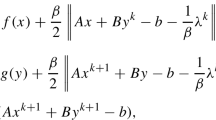Abstract
Learning partial differential equations (LPDEs) from training data for particular tasks has been successfully applied to many image processing problems. In this paper, we propose a more effective LPDEs model for vector-valued image tasks. The PDEs are also formulated as a linear combination of fundamental differential invariants, but have several distinctions. First, we simplify the current LPDEs system by omitting a PDE which works as an indicate function in current ones. Second, instead of using \(L_2\)-norm, we use the \(L_1\)-norm to regularize the coefficients with respect to the fundamental differential invariants. Third, as the objective function is not smooth, we resort to the alternating direction method to optimize it. We illustrate the properties of our LPDEs system by several examples in denoising and demosaicking of RGB color images. The experiments demonstrate the advantage of the proposed method over other PDE-based methods.






Similar content being viewed by others
Notes
The images are padded with zeros of several pixels width around them, so that the Dirichlet boundary conditions \(u_{m}(x,y,t)=0, v_{m}(x,y,t)=0, (x,y,t)\in \varGamma\), are naturally fulfilled.
The images are padded with zeros of several pixels width around them such that the Dirichlet boundary conditions \(u^c_{m}(x,y,t)=0, (x,y,t)\in \varGamma\), are naturally fulfilled.
References
Arbelaez P, Fowlkes C, Martin D (2013) The Berkeley segmentation dataset [Online]. Available: http://www.eecs.berkeley.edu/Research/Projects/CS/vision/bsds/
Aubert G, Kornprobst P (2006) Mathematical problems in image processing: partial differential equations and the calculus of variations, vol 147. Springer, New York
Beauchemin SS, Barron JL (1995) The computation of optical flow. ACM Comput Surv (CSUR) 27(3):433–466
Beck A, Teboulle M (2009) A fast iterative shrinkage-thresholding algorithm for linear inverse problems. SIAM J Imaging Sci 2(1):183–202
Bingsheng H, Xiaoming Y (2013) Linearized alternating direction method of multipliers with Gaussian back substitution for separable convex programming. Numer Algebra Control Opt 22(2):313–340
Blomgren P, Chan TF (1998) Color TV: total variation methods for restoration of vector-valued images. IEEE Trans Image Process 7(3):304–309
Boyd S, Parikh N, Chu E, Peleato B, Eckstein J (2011) Distributed optimization and statistical learning via the alternating direction method of multipliers. Found Trends Mach Learn 3(1):1–122
Chan TF, Esedoglu S (2005) Aspects of total variation regularized \({L}^1\) function approximation. SIAM J Appl Math 65(5):1817–1837
Combettes PL, Wajs VR (2005) Signal recovery by proximal forward–backward splitting. Multis Model Simul 4(4):1168–1200
Deng W, Yin W (2016) On the global and linear convergence of the generalized alternating direction method of multipliers. J Sci Comput 66(3):1–28
Ehrhardt MJ, Arridge SR (2013) Vector-valued image processing by parallel level sets [online]. Available http://www0.cs.ucl.ac.uk/staff/ehrhardt/software.html
Ehrhardt MJ, Arridge SR (2014) Vector-valued image processing by parallel level sets. Image Process IEEE Trans 23(1):9–18
Esser E (2009) Applications of Lagrangian-based alternating direction methods and connections to split Bregman. Cam Report
Estrada FJ (2010) Image denoising benchmark [online]. Available http://www.cs.utoronto.ca/strider/Denoise/Benchmark/
Figueiredo MA, Nowak RD, Wright SJ (2007) Gradient projection for sparse reconstruction: application to compressed sensing and other inverse problems. IEEE J Select Top Signal Process 1(4):586–597
Goldstein T, Osher S (2009) The split Bregman method for L1-regularized problems. Siam J Imaging Sci 2(2):323–343
Gunturk BK, Altunbasak Y, Mersereau RM (2002) Color plane interpolation using alternating projections. IEEE Trans Image Process Publ IEEE Signal Process Soc 11(9):997–1013
Li C, Xu C, Gui C, Fox MD (2005) Level set evolution without re-initialization: a new variational formulation. In: Computer vision and pattern recognition, 2005. CVPR 2005. IEEE Computer Society Conference on. vol 1, pp 430–436. IEEE
Lin Z, Liu R, Su Z (2011) Linearized alternating direction method with adaptive penalty for low-rank representation. Advances in neural information processing systems, pp 612–620
Lin Z, Zhang W, Tang X (2008) Learning partial differential equations for computer vision. Tech. rep., Technical report, Microsoft Research, MSR-TR-2008-189
Lin Z, Zhang W, Tang X (2009) Designing partial differential equations for image processing by combining differential invariants. Tech. rep., Technical report, Microsoft Research, MSR-TR-2009-192
Lions JL (1971) Optimal control of systems governed by partial differential equations. Springer, New York
Liu R, Cao J, Lin Z, Shan S (2014) Adaptive partial differential equation learning for visual saliency detection. In: CVPR
Liu R, Lin Z, Zhang W, Tang K, Su Z (2010) Learning PDEs for image restoration via optimal control. In: ECCV
Liu R, Lin Z, Zhang W, Tang K, Su Z (2013) Toward designing intelligent PDES for computer vision: an optimal control approach. Image Vis Comput 31(1):43–56
Liu R, Lin Z, Zhang W, Tang K, Su Z (2013) Toward designing intelligent PDEs for computer vision: An optimal control approach. Available http://www.cis.pku.edu.cn/faculty/vision/zlin/zlin.htm
Malioutov DM, Cetin M, Willsky AS (2005) Homotopy continuation for sparse signal representation. In: ICASSP. vol 5, pp v-733. IEEE
Martin B, Andrea CM, Stanley O, Martin R (2013) Level set and PDE based reconstruction methods in imaging. Springer, New York
Osher S, Rudin LI (1990) Feature-oriented image enhancement using shock filters. SIAM J Numer Anal 27(4):919–940
Perona P, Malik J (1990) Scale-space and edge detection using anisotropic diffusion. Pattern Anal Mach Intell IEEE Trans 12(7):629–639
Rudin LI, Osher S, Fatemi E (1992) Nonlinear total variation based noise removal algorithms. Phys D 60(1):259–268
Sapiro G (2006) Geometric partial differential equations and image analysis. Cambridge University Press, Cambridge
Sochen N, Kimmel R, Malladi R (1998) A general framework for low level vision. IEEE Trans Image Process 7(3):310–318
Tao M (2014) Some parallel splitting methods for separable convex programming with the \(o(1/t)\) convergence rate. Pacif J Opt 10(2):359–384
Yang J, Yuan X (2011) Linearized augmented Lagrangian and alternating direction methods for nuclear norm minimization. Math Comput 82(281):301–329
Zhao Z, Fang C, Lin Z, Wu Y (2015) A robust hybrid method for text detection in natural scenes by learning-based partial differential equations. Neurocomputing 168:23–34
Acknowledgements
The authors thank the NSFC support (Nos. 61471369 and 61503396) and the open Research Foundation of State Key Laboratory of Astronautic Dynamics (Nos. 2013ADL-DW0101 and 2014ADL-DW0102).
Author information
Authors and Affiliations
Corresponding author
Appendix
Appendix
When each of them gets the minimum, the functional \(J(\mathbf {u}_m,\mathbf {a})\) (8) get the minimum. We simply write \(u^c_m\) as \(\varphi\) and fix \(u^k_m\) \((k\ne c)\) when we derive the formulation next. We divide \(J(\varphi ,\mathbf {a})\) into two parts
For the first part, we have
For the second part, we first define \(F(\varphi ,\mathbf {a})=\sum _{i=0}^{36}a^c_i (t)\mathbf {inv}_i (\varphi )\), Then, we get
where \(Q=\varOmega \times [0,T]\) and \(\text {d}Q={\text { d}}\varOmega {\text { d}}t\).
We first compute \(F(\varphi +\varepsilon \delta \varphi ,\mathbf {a})-F(\varphi ,\mathbf {a})\), and it equals
where
From the above formulations, we can get
As the perturbation \(\delta \varphi\) should satisfy that \(\delta \varphi |_{\varGamma }=0\) and \(\delta \varphi |_{t=0}=0\). Integrating by parts, we have
If \(\frac{\mathrm {D}L}{\mathrm {D}\varphi }\) exists, the boundary conditions must satisfy the equation as follows
Then, we get the G\(\hat{a}\)teaux derivative
When the functional gets the minimum, it should satisfy the follow PDE with the initial condition \(u^c_m|_{t=0}=I^c_m\),
Rights and permissions
About this article
Cite this article
Jiao, Y., Pan, X., Zhao, Z. et al. Learning sparse partial differential equations for vector-valued images. Neural Comput & Applic 29, 1205–1216 (2018). https://doi.org/10.1007/s00521-016-2623-y
Received:
Accepted:
Published:
Issue Date:
DOI: https://doi.org/10.1007/s00521-016-2623-y




